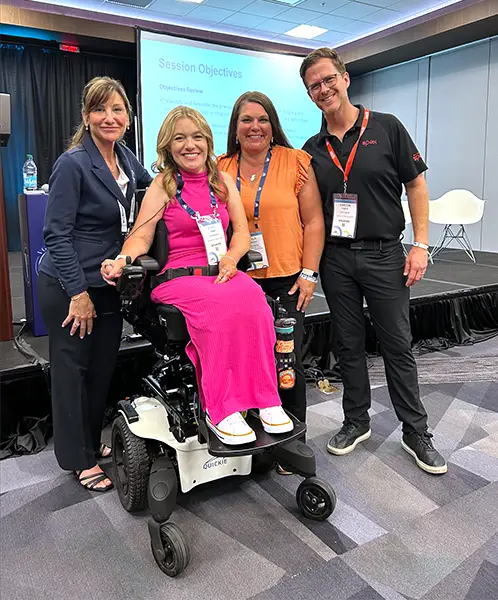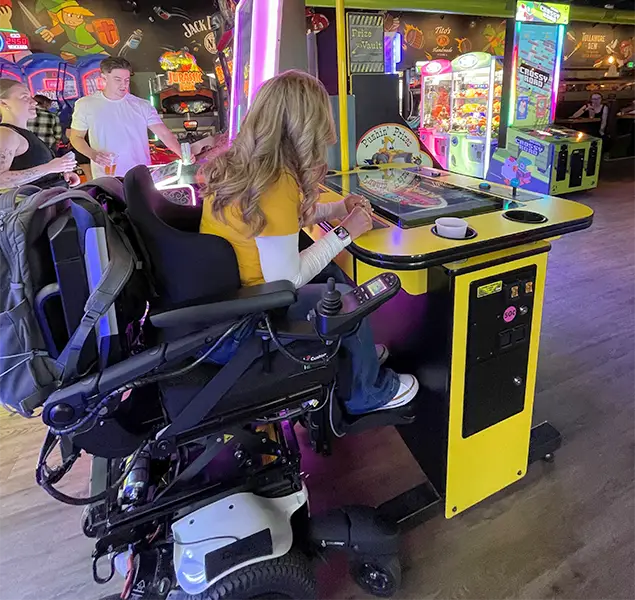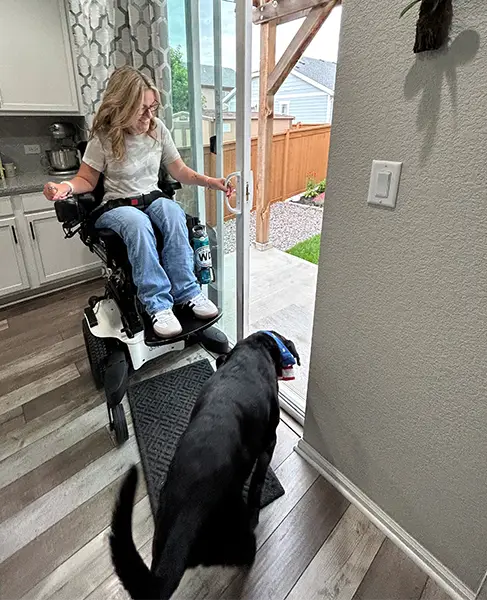Our recent blog post highlighted the many benefits of power seat elevation, outlined coverage criteria, and offered practical tips on incorporating targeted questions into evaluations to better understand how this feature can support riders who use power wheelchairs. The clinical and functional advantages of power seat elevation are well documented and widely supported across the industry, reinforcing that this feature is both reasonable and necessary for people using complex rehabilitative power-driven wheelchairs.
To recap, power seat elevation offers a range of benefits for wheelchair riders, including:
- Enhanced reach: Enables riders to access high shelves and other elevated surfaces, promoting greater independence.
- Improved transfers: Supports safer and more efficient sit-to-stand and lateral transfers.
- Ergonomics and safety: Improves posture at desks and enhances safety when using kitchen appliances or reaching elevated areas.
- Better visibility: Increases line-of-sight in public spaces, improving navigation and social interaction.
- Caregiver assistance: Eases the physical demands on caregivers during personal care, transfers, and when managing slings.
I recently had the pleasure of presenting at a conference alongside Jenny Siegle, a Sport Producer and passionate advocate for Complex Rehab Technology and Disability Awareness. During our panel discussion, Jenny demonstrated how adjusting her seated height to match the other speakers not only improved her visibility to the audience, but also enhanced her confidence, engagement, and connection with others. Her QUICKIE Q700 M wheelchair's C-Me function, which allows her to elevate while moving at walking speed, is another powerful example of how this technology supports mobility and social participation.

To provide a firsthand perspective on the functional impact of power seat elevation, Jenny has graciously agreed to share her story.
Jenny's Story: Elevating at "Mile High" to Achieve Another Level of Independence
Freedom is not a luxury. I thought about this statement often when seat elevate was referred to as a luxury, not a medical necessity. I use seat elevate on my power wheelchair multiple times per day and it provides me with a level of freedom that I will never take for granted.
I had my first chance to try seat elevate back in 2012 when I was presented with the opportunity to be a brand ambassador for Sunrise Medical. When discussing the different options for my power wheelchair, I was asked if I wanted the power seat elevate function. I never used one before so I really didn't think I would use it very often. Boy, was I wrong!
At first, I only considered all the social benefits that a seat elevate would bring me. I go to a lot of concerts, and I often have a hard time seeing when people stand up, but it wasn't a problem with my seat elevate! When going to restaurants with friends and family, I never could sit at a high-top table, but I was able to with my seat elevate! I've always loved playing video games, but it's hard for me to do so in an arcade. My seat elevate allows me to "level up" and enjoy something that I wasn't able to do before.

I'm a full-time producer for Altitude Sports, a regional sports network in Denver, Colorado and I work with a lot of current and former athletes. It was always hard for me to have conversations with them because I'm a very petite person and have a soft-spoken voice. My seat elevate was a gamechanger! To be able to have conversations with them at eye level gave me a whole new sense of confidence that I didn't know I needed.
Power seat elevation has given me so much more independence at work. As a producer, no two days at work ever look the same. Sometimes I'm in meetings all day, sometimes I'm producing content on location, and sometimes I'm on my computer responding to emails and building paperwork for future projects. I have my own office and without my seat elevate, I wouldn't be able to reach the light switch. If I'm producing a show in the studio, I ride the elevator multiple times per day. Without my seat elevate, I would not be able to reach the buttons inside. I'm also moving between different locations like our control room, edit bays, and tape room. Depending on what time of day it is, I might be the only one utilizing those locations and need to reach equipment that is stored on higher level shelves. Without my seat elevate, I would have to ask for help or have costly modifications made. Since I have my seat elevate, none of those considerations are necessary.
When I get home from work, my day does not stop and neither does the use of my seat elevate. I have the most amazing black lab named Riley and the first thing I do when I get home is put him outside to go potty. I have a sliding door and the only way that I can open it independently is if I use my seat elevate to reach the lock and handle.

I like to take advantage of modern day technology to do things like control lights or change the temperature on my thermostat. Unfortunately, technology does fail. Without my seat elevate, I would not be able to reach the light switches or adjust the temperature independently in my home.
Advocating for Access
I have been an advocate throughout my life, but I have become very focused on protecting access to complex rehab technology since 2009. After I quickly learned how much my seat elevate impacted my day, I needed to fight for access to such an important part of my power wheelchair. It was a huge accomplishment and relief when power seat elevation was no longer seen as a luxury, but a medical necessity. This officially happened in May 2023.
Becoming an advocate first began as a personal mission. My mom helped me advocate a lot as a child. A couple of issues we had to advocate for was when I was not allowed to attend my home middle school because I used a wheelchair and when the school board was going to cut back services provided by nurses. I'm happy to say we had positive outcomes with both situations.
As I got older though, I learned that I was not just advocating for myself, but for others as well. If I can help other people along the way, then it feels like such a more rewarding process. That same sentiment was true when power seat elevation was approved to be purchased through Centers for Medicare & Medicaid Services (CMS). It was a piece of equipment that I truly felt was a medical necessity and it is wonderful to know that more people get to experience a similar feeling of freedom that I get to experience every day.

Jenny Siegle is 41 and was paralyzed at nine months of age from Transverse Myelitis. She is an incomplete C4/C5 quadriplegic and uses a power wheelchair for her daily mobility. Jenny was the first child in the state of Colorado to get a power wheelchair when she was just two years old. She was originally paralyzed from the neck down, but has regained partial use of her upper body after many years of physical and occupational therapy. Jenny currently drives and lives independently in her own home. She graduated with a BA in Journalism and Mass Communications from the University of Northern Colorado in 2004.
She was Ms. Wheelchair Colorado in 2004, enjoys public speaking, is an active member of Unite4CRT, and is a disability advocate. As a disability advocate, Jenny has traveled to Washington, D.C. multiple times since 2009. She meets with members of Congress to discuss the importance of continues access to Complex Rehab Technology. Jenny was given the NRRTS Distinguished Service Award in 2020 for her advocacy efforts.
Please visit her website at jennysiegle.com for more information or to contact her.
From Evaluation to Empowerment: Unlocking the Benefits of Seat Elevation
Jenny's story is a powerful testament to how advanced wheelchair technologies can transform daily life – promoting independence, safety, and overall quality of life for power wheelchair riders. Her willingness to share her experience helps others better understand the real-world functional benefits of power seat elevation.
As a clinician or evaluator, are you advocating for the riders you serve? Start the conversation. Ask the right questions. Consider how implementing power seat elevation could change their life.
If you have any specific questions about the technology or need support in navigating the coverage criteria, feel free to reach out – we're here to help.
Karla Sonderland graduated with a master's degree in Occupational Therapy from the University of Mary in North Dakota. She has 20 years of experience with a focus on individuals with intellectual and developmental disabilities. She brings to the team her knowledge and understanding of providing 24-hour care to individuals with multiple caregivers as well as helping individuals transition to alternate living arrangements with optimal assistive technology to ensure their safety and participation. Karla lives with her husband and three children in Iowa and manages the Midwest Clinical Education program.